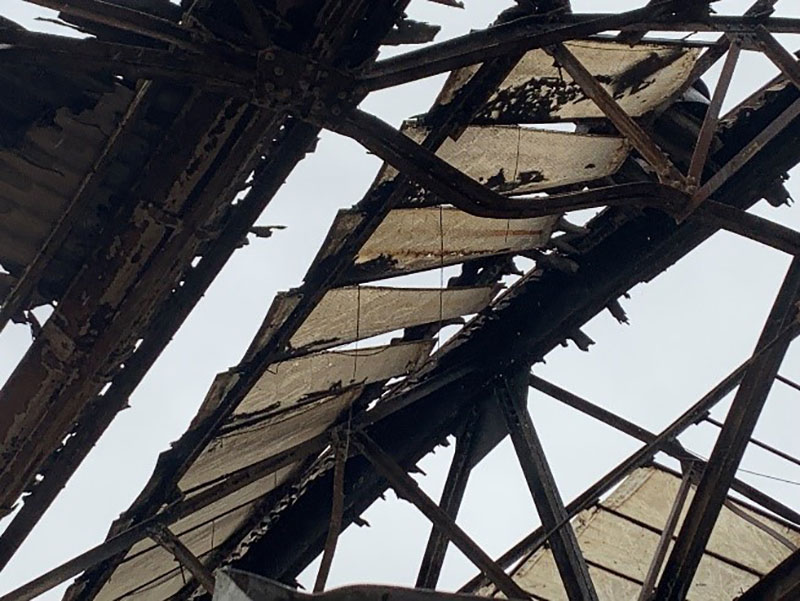Dangers of asbestos exposure following a fire – should I be worried?
Major fires are always a cause for concern – not only for the owners and managers of properties that may be affected, but also for the broader public, who understandably often have great concern about the dangers that an outbreak of fire can present.
Fires are not only visually dramatic events, frequently creating large smoke plumes; they can also pose genuine and meaningful risks to human health. Direct contact with the smoke plume, for instance, may cause breathing difficulties, coughing, a sore throat, and watery eyes.
Fortunately, even many people who do experience such symptoms as a consequence of being in close proximity to a fire, quickly recover after the exposure and do not suffer from any long-term health implications.
What isn’t so frequently talked about, however, is the combination of a major fire breaking out in a building in which asbestos is present. So, what do you need to know about the potential health hazards that asbestos could present during and after a fire?

Understanding asbestos
Today, asbestos is a notorious carcinogen; it is known that inhaling or ingesting this naturally occurring substance can present an elevated risk of developing a potentially fatal disease, such as mesothelioma or asbestos-related lung cancer.
However, for much of the 20th century, asbestos was treated as a “wonder material” – one that was physically strong, fire-resistant, and relatively affordable and available. It was first commercially mined in the 19th century, and went on to be extensively used in such UK industries as construction and shipbuilding.
As the 20th century wore on, awareness of the serious health risks presented by asbestos increased. Only towards the end of 1999, however, were all forms of asbestos in the UK finally banned from use in any future construction projects.
Even in the aftermath of this ban, much asbestos remained present in UK buildings – public, residential, and commercial – dating from before the year 2000.
This means that, in the event of any disturbance to such asbestos-containing materials (ACMs) in older buildings – as, for example, a fire could theoretically cause – asbestos fibres could be released into the air. This, in turn, could imperil the health of many people nearby.
Asbestos-containing materials in buildings
During the peak period of asbestos use in the UK, the substance found its way into a huge range of products. These included the likes of asbestos insulating board (AIB), asbestos cement products, roofing felt, sprayed coatings, textured coatings, lagging, and loose asbestos in ceiling and floor cavities.
The extremely wide range of asbestos-containing materials (ACMs) that can potentially be found in a UK property constructed or renovated before the year 2000, means that if a fire breaks out, there can be a high risk of the flames reaching those materials.
Although – as we stated above – asbestos is partly known for its fire resistance, the historical tendency for asbestos to be mixed in with other materials for the manufacture of asbestos products, means a lot of fire damage can still be caused to such products.
If asbestos products are disturbed as a result of a fire, strands of the material can subsequently split into ever-smaller and thinner fibres that can become practically invisible to the human eye. Asbestos particles could therefore conceivably get into a person’s lungs, without the exposed individual being aware that this has happened.
Risks to firefighters, the public, and nearby residents
The good news is that, in the event of a fire occurring at a property near you that you know or suspect to contain asbestos, there are various factors that can help reduce the associated health risk.
When a fire does break out at a property – whether it is a residential, commercial, or public one – and the fire brigade is called, the custom is for the public to be urged to close their doors and windows, and to stay indoors until they are told otherwise by the emergency services.
This measure, on its own, can greatly help to protect local residents and the broader public from being directly exposed to asbestos fibres from a fire. As the public keep away from the fire or inside their own homes, firefighters will typically continue tackling the fire, while always keeping their equipment on. This helps to defend them against not only asbestos, but also any other potentially toxic substances – such as dust or gas – that may spread from a building during a fire.
In 2007, the Health Protection Agency (HPA) – the non-departmental public body that operated in the UK from 2003 until 2013 – published the results of a systematic literature review, aimed at identifying available information on the level of asbestos exposure that might result from fires, as well as the possible health impact of such exposures.
The study found that large-scale fires involving ACMs were a relatively common occurrence in the UK. It also discovered that various factors mitigated against members of the public being significantly exposed to asbestos after a fire involving ACMs. Those factors included:
- Not all ACMs in a given building necessarily being affected by the fire;
- Asbestos fibres being entrapped, such as in larger pieces of material;
- Respirable fibres (those that could be breathed in) being just a fraction of the total fibres released;
- Some fibres potentially being “denatured” (their natural qualities being taken away) at the elevated temperatures of a major fire;
- Concentrations of asbestos fibres being reduced by atmospheric dispersion and deposition, particularly as a result of rain; and
- The duration of any asbestos exposure being short.
The HPA report went on to state that “there is no direct evidence of long-term health risks from fires involving ACM, although the literature in this area is limited.”
None of the above, of course, should cause you to be complacent about the risks that asbestos may still present to people who are in close vicinity of a fire. Asbestos being disturbed during a conflagration can cause loose asbestos fibres to be released, which could lead to fibres landing on – and contaminating – sites some distance away from the original source of the blaze.
Nonetheless, the above study findings should hopefully give you a proportionate understanding of the level of risk that may or may not present itself if a building containing asbestos that you are responsible for – or a nearby property – catches fire.
Post-fire cleanup and demolition
Once a fire at a building that contains asbestos has been extinguished, it will be necessary to carry out careful and diligent work to clean up any asbestos debris. This process generally involves any larger fragments of ACMs being manually picked up, as well as possibly other measures, such as the use of road sweepers for wet mechanical cleanup.
But of course, such direct handling of asbestos materials at a fire site is not something that simply anyone can or should do. Indeed, even before any attempted removal of asbestos materials, it will be crucial to hire an asbestos professional who holds a licence from the Health and Safety Executive (HSE), and who will therefore be well-placed to carry out an assessment of the asbestos situation at the site.
Presuming the site is one for which you are responsible, you should also be arranging for a HSE-licensed professional to be undertaking the subsequent removal of any asbestos that may pose a risk to the public or future users of the site.
Such HSE-licensed asbestos removal contractors will follow all the necessary precautions and procedures, such as the wearing of protective clothing, the use of ‘wet’ collection processes, and the legally compliant disposal of asbestos. Bear in mind on the latter subject, that asbestos waste is defined as hazardous waste in accordance with the Hazardous Waste (England and Wales) Regulations 2005 and the List of Wastes (England) Regulations 2005.
In the words of the aforementioned HPA report, “if the clean-up is performed in an appropriate manner, the level of asbestos contamination in the affected area will be minimal. Thus the potential for long-term environmental exposures and thus the associated risk will be minimal.”
Regulatory framework and guidelines
The key overarching asbestos legislation that building owners (and those responsible for the maintenance and repair of such properties) need to be aware of, is the Control of Asbestos Regulations 2012, or CAR 2012.
Regulation 4 of CAR 2012 outlines a “duty to manage” asbestos in non-domestic premises. If an individual or organisation is a “dutyholder” for a given building, they will be expected to implement a number of measures to help keep people safe from asbestos risks.
Those measures include – but are not limited to – taking reasonable steps to determine whether ACMs are present in the given building, and the amount, location, and condition of any such materials. Dutyholders will also be expected to prepare, and keep up to date, a record of the location and condition of the ACMs, as well as to put together and implement a plan for the management of these materials with people’s safety in mind.
Taking steps like the above to ensure the responsible, diligent, and safe management of asbestos on a given site, will further help reduce the risks of dangerous asbestos fibres being released, in the event that a fire does one day break out at the premises.
The UK Government has set out that dutyholders who fail to have a plan to deal with asbestos on their sites – and who do not put that plan into action – could be hit with a fine of up to £20,000, and a prison sentence of as long as 12 months. Serious breaches could bring even more severe consequences than this.
You will have all the more reason, then, to be proactive about managing asbestos at any premises for which you are responsible, even if you do not judge the risk of fire at your property to be especially high.
Conclusion: whatever the fire-related asbestos risks, you should be proactive and vigilant
Evidence so far – including that brought together by the HPA in its report – indicates that the asbestos-related health risks arising from a fire at a building containing ACMs may not be as high as many people fear. However, this is not a reason to be complacent about asbestos management at your premises.
The fact is that fire can cause asbestos materials to be disturbed, and for fibres to be released, so the associated risks are unlikely to be zero. Plus, even once a fire at such a property has been extinguished, there will be a need for anyone managing the site to have a high level of asbestos awareness, and to arrange for careful handling of any ACMs during the cleanup and demolition process.
Even putting aside any specific asbestos risks, fires present considerable dangers to human life, limb, and property. So, even if the greatest dangers from asbestos fibre release during a fire are likely to be faced by firefighters rather than necessarily residents, workers and/or the public, you should still be doing everything possible to manage those risks.
Would you like to learn more about the accredited and licensed asbestos services that we can provide at Oracle Solutions, and to request your free quote? If so, please do not hesitate to contact us today.

Written by Mark Carter
Mark Carter is a renowned expert in asbestos management, offering clients vital guidance on compliance and safety. His expertise is invaluable for navigating asbestos regulations, ensuring both safety and legal adherence. Mark's role is central in providing effective asbestos-related solutions, helping clients achieve their business objectives with an emphasis on regulatory compliance and safety in asbestos management.
